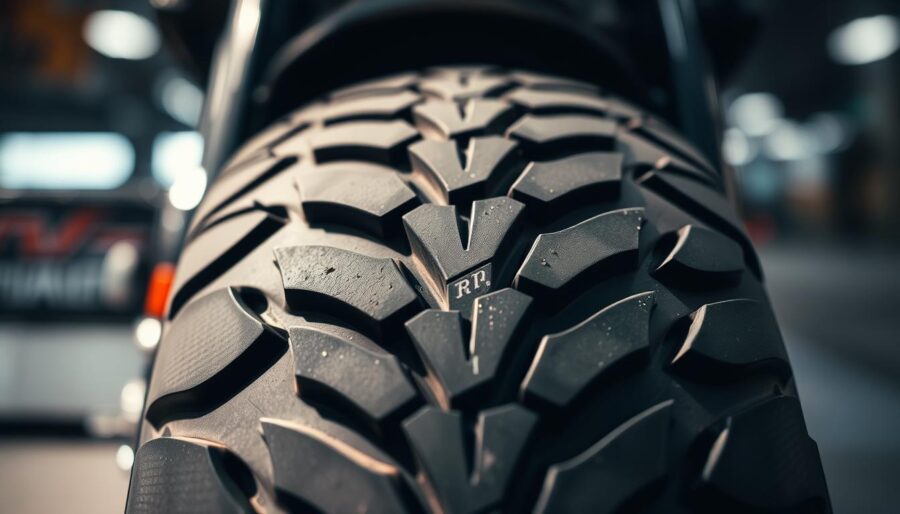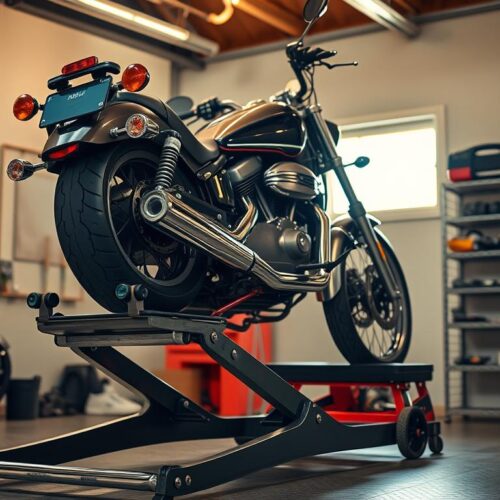Understanding the care of motorcycle tires is key for top performance and safety. Many bikers don’t pay enough attention to this critical aspect. But it’s vital for both your bike’s working and your safety while riding.
This guide will teach you all about keeping your tires in good shape. It covers how to check your tires, keep them lasting longer, and spot wear. Keep in mind, your tires are the sole link between your motorcycle and the road. So, taking good care of them is not just smart, it’s necessary.
Importance of Motorcycle Tire Maintenance
Your tires are the only parts that touch the road, only as big as a credit card. They carry the whole weight of the bike and rider, plus any extra fuel. It’s vital to keep them in good shape to stay safe and make your ride better. If you don’t, you could face serious dangers like tire blowouts, slipping, and hard steering.
Looking after your tires means more than making them last longer. Good tires mean you can handle your bike better and grip the road in all kinds of weather. They help you take corners safely, ride smoothly, and lower the chance of accidents. Keeping them in shape affects how well you ride.
| Issue | Impact on Safety | Impact on Performance |
|---|---|---|
| Tire Blowouts | Increases the risk of losing control | Sudden loss of grip and stability |
| Low Tire Pressure | Reduces responsiveness and increases stopping distance | Poor fuel efficiency and handling characteristics |
| Worn Tread | Decreases traction, increasing slip risk | Lowered cornering ability and overall performance |
For the best riding experience, keep your tires in great condition. Good tire upkeep means safe and fun riding every time.
Understanding Tire Components
When looking at your motorcycle’s performance, knowing the tire parts is key. Tread patterns are especially important. They affect your bike’s hold and balance on various grounds. Each pattern is made for certain riding situations, which means better grip and safety.
The sidewalls also play a big part. They carry the bike’s weight and soften the bumps. This makes your ride smoother. Inside the tire, linings keep the air pressure right, affecting road performance.
Knowing these tire parts helps you make smart choices about care and when to get new tires. Understanding tread patterns can even boost your confidence in your bike’s cornering skills. For more tips on picking the right tires for your ride, check out this helpful guide.
Checking Tire Pressure
It’s crucial to check your motorcycle’s tire pressure regularly. This ensures your ride performs well and lasts longer. Start by checking the pressure when your tires are cold. This gives the most accurate results. Your motorcycle’s manual will tell you the right PSI to maintain. This is key for the best handling and safety.
Too much air in your tires means less grip and uneven wear. This can make your ride rough. Not enough air causes too much heat and can lead to tire blowouts. By keeping an eye on your tire pressure, you can dodge these issues. You’ll have a safer and smoother journey.
Inspecting Tire Tread
Checking your motorcycle’s tire tread regularly is key to staying safe and performing well. Begin by looking over the tire tread for wear or damage signs. Search for flat spots, cracks, or items stuck in the tread. Uneven tire wear can point to issues like not enough air or misalignment.
Using a tread depth gauge helps measure the tread’s depth. This shows if the tread is deep enough for safe riding. In wet weather, having enough tread depth is crucial for good grip and traction. It keeps you safe while on the road.
Here’s a breakdown of standard tread depth measurements and their implications on tire wear:
| Tread Depth (mm) | Condition | Safety Implications |
|---|---|---|
| 3-4 mm | Good | Acceptable grip in most conditions |
| 1.6 mm | Worn | Reduced traction, especially in wet weather |
| Less than 1.6 mm | Unsafe | Increased risk of hydroplaning |
Watching your tire tread often helps keep your ride in top shape. Remember, low tread depth raises the chance of slipping. Fixing tire wear signs early improves your safety and ride.

Balancing Your Tires
Tire balancing is key to keeping your bike running well. It makes sure weight spreads out evenly over your tires. This gives you a smooth ride. If your tire is off balance, it wears out unevenly. This could shorten your tire’s life. You may feel your bike shake or drift to one side if this happens.
Keeping your tires balanced is good for them. It makes your bike handle better and stay stable when you’re riding. Balanced tires are also safer and more comfortable. By checking your tires regularly, your rides will be better. Plus, you’ll get more miles out of your tires.
Rotating Your Tires
Rotating your tires regularly keeps them in top shape. This process balances wear across all tires. Remember, you should rotate tires every 3,000 to 5,000 miles. But, always check your motorcycle’s manual for exact instructions.
If you don’t rotate your tires, you might notice they wear down unevenly. This can affect how your motorcycle handles and its safety. By rotating them, you make sure they all grip the road equally. This means better control and a safer ride.
Storage and Seasonal Care
Proper tire storage is key for keeping your motorcycle tires in good shape during breaks. Start winter prep by cleaning your tires well to get rid of dirt. Then, pump them up to the suggested level and use tire covers. This helps avoid cracks and stops flat spots from forming.
In the summer, heat can damage your tires faster. Keeping them out of the sun helps keep them strong. It’s also crucial to check the tire pressure regularly, as tires that are properly inflated work better and last longer. Following these tips for each season will help keep your motorcycle in top shape, ensuring you’re safe on the road.
Choosing the Right Tires
Finding the perfect motorcycle tires is essential for safety and performance. Different riding demands mean you need specific tires. For example, sport tires work best for fast cornering. Touring tires are great for long rides, and off-road tires better handle rough paths.
You should check your motorcycle’s owner manual before picking tires. It tells you what fits your bike and suggests the best types. Think about where and how you ride, like the weather and the roads. Switching tires can change how your motorcycle handles and feels on the road.

Tire Repair and Patching
Every motorcycle owner should understand tire repair’s importance. A minor puncture can often be fixed quickly and affordably by patching. But, it’s key to know when a tire just needs a patch or when it should be fully replaced for safety.
Always check how bad the damage is. If the puncture is in the tread and smaller than 1/4 inch, you can likely patch it. But, if the damage is big, like a sidewall puncture, or the tread is really worn, get a new tire to stay safe and keep your bike running well.
- Follow manufacturer guidelines for safe tire repair.
- Inspect the tire closely before deciding on patching.
- If in doubt, consult a professional for support in tire maintenance.
Remember, good tire upkeep includes proper patching. Clean the punctured spot well and accurately follow the patching steps. Skipping these steps can cause more problems, risking your safety and the tire’s condition.
Knowing When to Replace Tires
It’s key to know when it’s time to change your tires to stay safe. Watching your tires for signs of wear can help avoid accidents and keep your ride smooth. Be on the lookout for:
- Low tread depth: Tires need enough tread for proper grip and stability.
- Visible damage: Cracks, bulges, or punctures mean tires might be unsafe.
- Age of the tire: Older tires can perform poorly, even if the tread looks good. Use the DOT code to find out your tires’ age.
Many experts say you should get new tires every few years because things like sun and air can make them worse over time.
Learning about your tire’s age and shape helps keep you safe on the road. If you see any signs of wear, don’t wait for one more trip. Checking often and fixing problems early is key for road safety.
Maintaining Tires On Long Rides
Going on long rides is exciting. However, it’s crucial to pay close attention to your tires. Always check your tire pressure and look for wear or damage before you leave. Doing this can prevent problems that might interrupt your trip.
You should also bring an emergency kit. Make sure it has a tire pressure gauge, a repair kit, and a portable air pump. These tools will help you handle any tire issues on the road. Check your tires often during your trip. This keeps you safe and makes your ride better.
Resources for Motorcycle Tire Maintenance
Keeping your motorcycle tires in good shape is easier with the right tools. You’ll need a pressure gauge to check air levels, a tread depth gauge to check wear, and a tire repair kit for quick fixes. Checking these regularly makes your ride safer and keeps your bike running smoothly.
If you can’t fix tire problems yourself, it’s important to get professional help. Service centers have the right tools and know-how for complex issues. Local motorcycle shops are also great places to find help, with experts who know your bike’s specific needs.
For more help, check out websites focused on motorcycle care. Flextudo is a great site for tips on tire pressure and overall maintenance. These online resources can boost your knowledge and help you take better care of your motorcycle.




